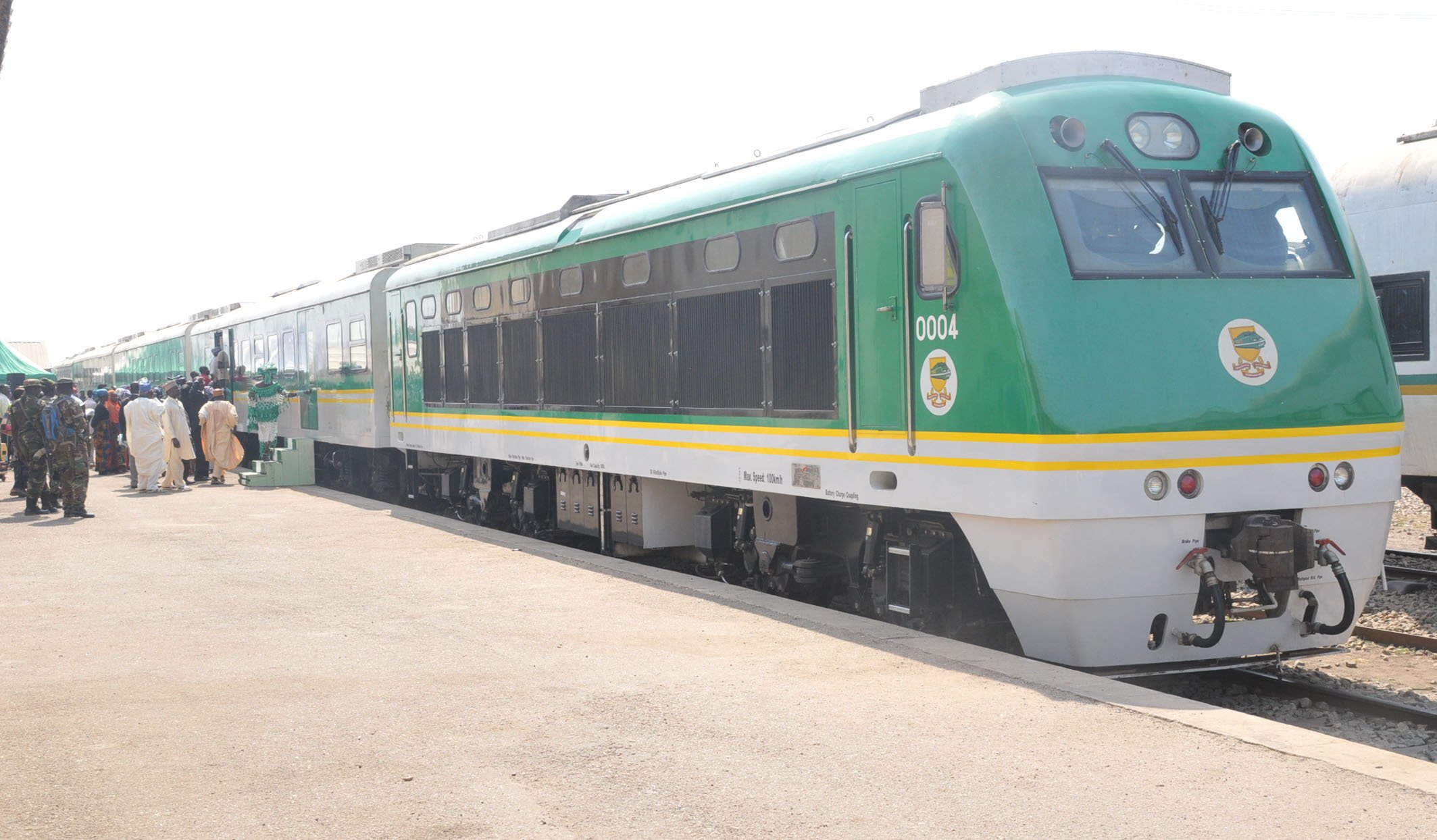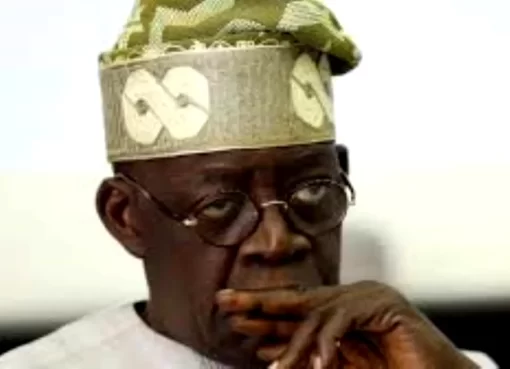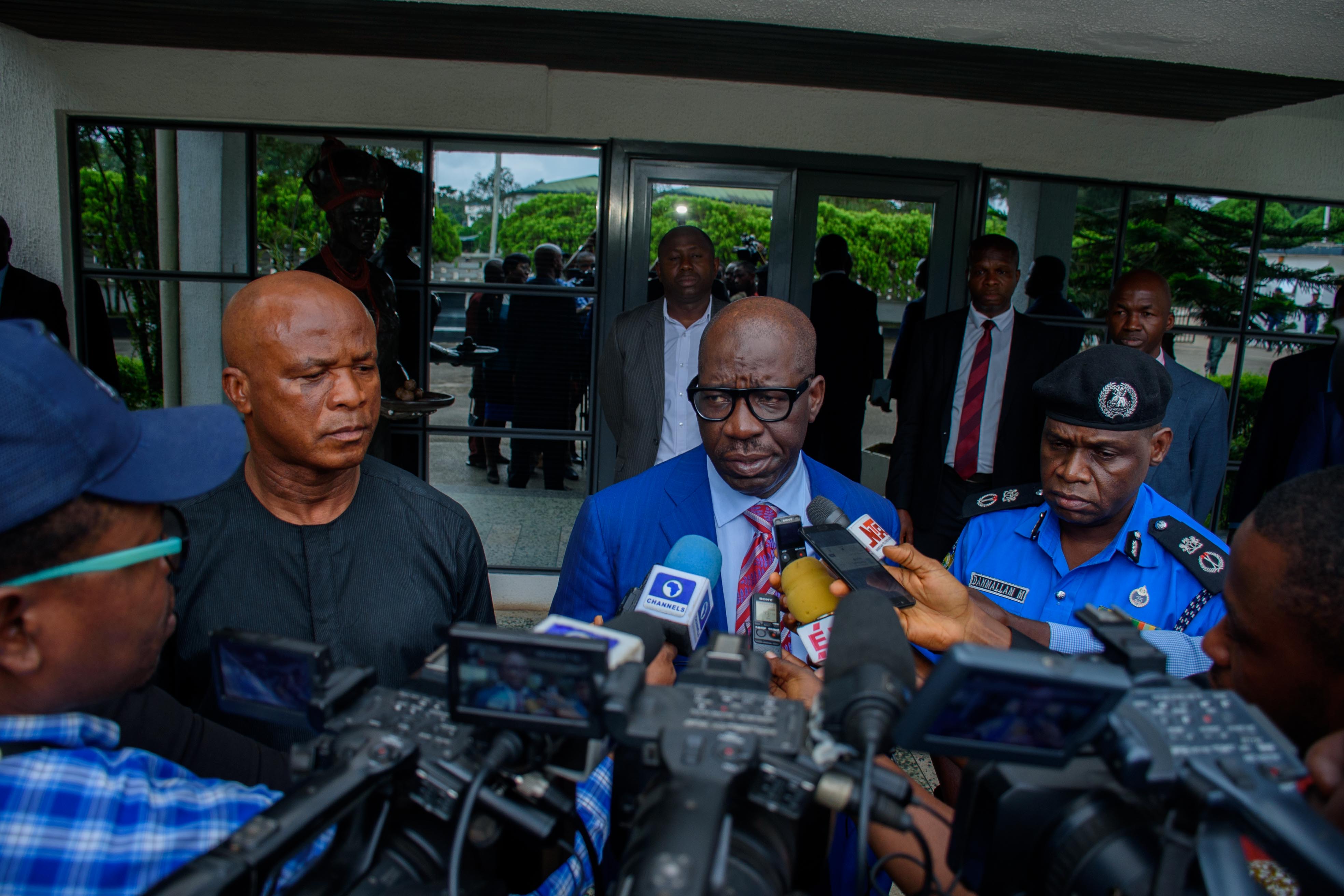The poor state of the road, occasioned by the neglect of the 27km-long Marina-Okokomaiko section of the Lagos light rail project, mirrors the rot that is beneath the façade of “excellence” which successive governments in Lagos have continued to pride themselves with since 1999. While similar projects elsewhere have since been built and expanded beyond their original corridors, the Lagos light rail has suffered neglect after 17 years of failed promises. Again, apart from the accountability issue raised in connection with the discrepancies in the funding costs, the failure of the government to complete the rail project in almost two decades has had negative effects on the socio-economic life of Lagos residents. More than a decade since the construction of the Lagos Light Rail has commenced, it has failed to see the light of the day.
The rickety vehicle huffed and puffed for the umpteenth time at the Iyana-Iba section of the Lagos-Badagry Expressway. The driver, a middle-aged man dressed in African wax fabric, struggled to negotiate his ways through contortions, craters and ditches.
At the open market located some metres away from Volkswagen bus-stop, the driver wrestled with the steering to maintain balance, maneuvering his way through a ditch with one hand and wiping off beads of sweat running across his forehead with the other.
Passengers who have had to endure the pain-inducing journey from the Agbara end of the road screamed in frustration. Others lashed out at the government for abandoning the road.
It was in the autumn of March and the rains had not begun to pour. There were no signs of flooding on the road yet, neither were there muddy sections on either side. But commuters and car owners groaned and cried over the pathetic state of the road, occasioned by an abandoned rail project.
The poor state of the road, occasioned by the neglect of the 27km-long Marina-Okokomaiko section of the Lagos light rail project, mirrors the rot that is beneath the façade of excellence that successive governments in Lagos have continued to pride themselves with since 1999.
While similar projects elsewhere have since been built and expanded beyond their original corridors, the Lagos light rail has suffered neglect after 17 years of failed promises. And apart from the accountability issue raised in connection with the discrepancies in the funding costs, the failure of the government to complete the rail project in almost two decades has had negative effects on the socio-economic life of Lagos residents.
In December 2003, when the contract for the construction of the Lagos light rail network was flagged off by the Bola Tinubu administration, commuters and motorists jumped for joy. The $135 million proposal was part of the greater Lagos Urban Transportation Project, which was to be handled by the Lagos Metropolitan Area Transport Authority (LAMATA).
LAMATA initially planned to establish a Bus Rapid Transit (BRT) system, to run from Mile 12 to Lagos Island. In 2008, the agency chose to focus on a seven-line network codenamed Red, Blue, Green, Yellow, Purple, Brown and Orange lines. The Blue Line is expected to be 27km long, connecting Okokomaiko to Marina, with an estimated completion date of 2011.

Dotted along the densely populated Okokomaiko-Mile 2 axis of Lagos are important economic markers such as the Tradefair Complex and the Alaba International market. The axis also plays host to the road that leads to Nigeria’s border with neighbouring Benin Republic – Seme Border. Many Lagosians residing on the corridor also work and own businesses in far-flung places in Lagos, including Victoria Island and Ikeja.
The rail project was, therefore, expected to open up that axis of Lagos to the West African market, with ripple effects on the local economy. But years after the award, the pains of commuters and transport workers have remained.
“From Under-Bridge to Barracks, you can spend three hours on a very good day,” Cynthia, a student of the Lagos State University, LASU, lamented.
Cynthia told this newspaper that transport fares along the road have always been on the high side due to its poor state, but commuters’ troubles have doubled since the ban on commercial motorcycles (Okada) took effect earlier in the year in strategic parts of the state.
“People trek most often on this road,” she said, adding that from Abule-Osun through Barracks, it is a common sight to see people alight from vehicles and resort to trekking to Iyana-Iba.
“Robbers also use the opportunity to rob commuters and car owners of their belongings at night on this road,” Kelechukwu Ogu, a trader at the famous Alaba International Market, added. “At least, I know of two people who have witnessed robbery on this road, especially at Volks bus-stop. And some other people have died.”
Some commuters lamented the hardship they go through on the road. They also called on the government to look into the speedy completion of the rail project to ease their stress.
For Banji Alade, a private estate developer, the cost of transport and poor return on investment on real estate projects are his major headaches.
“If you want to go from Ajangbadi to Mile-2, you should prepare to spend about a thousand naira or more,” he said. “It wasn’t this bad before now; there were days we spent less than N400 to get to Mile-2. But over the years, the decay on the road has brought more hardship on residents. It’s why properties around here attract very little value; the road is a major hindrance.”
Other commuters who spoke with PREMIUM TIMES maintained that the pains they go through on the road would have been minimal had the Lagos State Government completed its abandoned rail project, a part of which is the road construction.
Lagos Rail Project
The Lagos Rail Mass Transit (LRMT) network is a major component of the Strategic Transport Master Plan (STMP) which has been developed as a compass for the development of public transport infrastructure in the state. According to the Lagos Metropolitan Area Transport Authority (LAMATA), the STMP is a 30-year plan put together under series of intensive researches, studies, and analyses of future transportation demands and needs of Lagos State as Nigeria’s commercial and economic hub and one of the world’s fastest growing mega cities.

The master plan gave birth to the Lagos Urban Rail Network (LURN), a network of urban rail-based systems covering seven major corridors of high commuter traffic demand within and beyond the metropolitan Lagos extending to border areas with states like Ogun and Oyo. The Urban Rail Network consists of six railway lines planned along priority and high commuter demand corridors within the Lagos metropolis and farther. The six lines link the major population and activity centres in the state, as well as taking advantage of existing transport corridors.
The lines are Blue Line (Okokomaiko to Marina); Orange Line (Redeem to Marina); Brown Line (Mile 12 to Marina); Purple Line (Redeem to Ojo); Green Line (Marina to Lekki); Yellow Line (Otta to Iddo) and Red Line (Agbado to Marina via Iddo and Muritala Mohammed International Airport).
LAMATA says that the types of trains proposed for the Blue Line Rail Project are Electric Multiple Units (EMUs). EMUs are emissions-free and therefore do not pose problems of environmental pollution usually associated with conventional diesel locomotives.
However, more than a decade since the construction of the rail line has commenced, it has failed to see the light of the day. The failure has equally subjected residents to suffering, especially on the Lagos-Badagry corridor, as well as other parts of the state.
From Jakande to Sanwo-Olu: A history of failed targets
At about 1:00pm on July 16, 1983, the flag-off of the N689 million Lagos metroline project was done in Lagos. The project was aimed at easing the traffic jam in Lagos and the first phase was projected for completion in July 1986.
Although criticised in some quarters as a waste of resources, the project was conceived during the tenure of Lateef Jakande, Lagos state governor between 1979 and 1983. Mr Jakande vigorously defended the project, conceived to have 30 trains, each running 28.5 kilometres on raised concrete tracks from Marina to Agege.
However, in 1985, the project was terminated by the military administration of Muhammadu Buhari. Analysts said that decision, taken two years after the project started and a year to the completion of the first phase, came at a loss of over $78 million to Lagos taxpayers.
In the early 2000s, almost two decades after Mr Buhari’s military junta scrapped the project, the then governor of the state, Bola Tinubu, reviewed the plan for the state to have a functional rail system. A formal announcement was made in December 2003.
The first two lines of the urban rail project were estimated to cost $1.4 billion. The Blue line was designed to be 27km long, connecting Okokomaiko to Marina. However, up until Mr Tinubu left office in 2007, little progress was made on the project.
In 2008, the then newly elected governor, Babatunde Fashola, promised to revive the project, with a completion date of 2011. In 2009, the project kicked off effectively and was handled by China’s state-owned China Civil Engineering Construction Corp (CCECC).
From Iddo, the Blue line running on an elevated platform would move along the National Theatre station and make a descent at Iganmu to join the Lagos-Badagry Expressway. This was ostensibly conceived to ease link between Nigeria and neighbouring West African countries, including Benin and Togo. It would run through Alaba Suru, Mile 2, Agboju-Amuwo, Alakija, Trade Fair station, Volkswagen, Iyana-Iba, LASU, PPL and terminate at Okokomaiko station.
A number of rail crossings with elevated road structures were also conceived to be built along the lines. Pedestrian bridges will be constructed over the Nigerian Railway Corridor. Cable ducts and walkways, in addition to drainage system with two walls will be built along different sections of the lines.
When the 2011 target failed, Mr Fashola said that June 2013 was the completion date for the first phase of the project. But the projection failed yet again. Thereafter, Mr Fashola said it would be completed before he left office in 2015 but, again, this promise could not be fulfilled.
Speaking to Guardian newspaper on why the targets failed, Mr Fashola’s spokesperson, Hakeem Bello, said: “Let me draw your attention to the fact that when the governor said that (rail will be completed in June 2013), he also mentioned that all these will be subject to availability of funds. So, if the World Bank loan is still being held up by the Federal Government and there are still issues, definitely it would be impossible to do magic.”
Immediately the immediate past governor of the state, Akinwunmi Ambode, came into office in 2015, he promised that by December 2016, the first phase would be commissioned. Asked about a start date for the line in an interview conducted in November 2015, Mr Ambode told Reuters: “By December 2016, that should be delivered.”
But Mr Ambode left office four years after in 2019 without completing the project.
Last December, the incumbent governor, Babajide Sanwo-Olu, said the blue line rail project will be completed in 2020 and become operational in 2021. Mr Sanwo-Olu spoke after inspecting the five-kilometre- long beam bridge constructed from Iganmu to Marina, as part of the fourth phase of the project. He claimed that the completion of the sea-crossing track indicated his administration’s commitment towards finishing the state-funded track started in 2009.
“The aim of this rail project is to reduce the travel time through an effective and efficient inter-modal transport system. It is also key to the building of a 21st Century economy, which is central to the vision of a greater Lagos. We are committed to delivering this project next year and ensuring its operation starts in 2021,” he explained.
Blurry prospects
Despite the promises made over the years by successive governments, there are very little indications that the project would be completed as and when promised.
In February, the CCECC took to social networking site Twitter to announce the completion of the beam bridge of the sea-crossing for the project. “Constructed by CCECC, the continuous beam bridge of the sea-crossing for the Lagos Blue Line Light Rail project has been completed. It is the first sea-crossing bridge in West Africa,” it tweeted.
But when PREMIUM TIMES went on an inspection of the Blue line rail project in March, it was observed that there were still numerous aspects of the project crying for attention.
For instance, from the Okokomaiko end of the road through to Abule-Ado, via Volks, Barracks, Under-Bridge, Tradefair and Abule-Osun, there are no visible signs of works being done on the project. However, one of the two bridges being built for the Blue line has been completed at Mile 2.
Although now abandoned, the track has equally been laid from Mile-2 through Suru Alaba to Orile.
Similarly, a five-kilometre- long beam bridge has been constructed from Iganmu to Marina, but many Lagosians continue to wonder when the project would finally be completed to ease the transport mess across the city.
When this reporter visited the track yet again in November, the various stops reeked of faeces, trash, and urine. Several stops along the lines had heaps of trash and refuse on them. Between Mile 2 and Orile, commuters dumped refuse on different sections of the rail track with reckless abandon. At Suuru Alaba, the tracks have been taken over by thick grasses and fecal material.
Although there were barricades at strategic parts of the track in Orile Iganmu, people defied the barricade to defecate and urinate on the track.
However, from Orile to CMS, the track remains suspended in the sky, passing through the Lagos Lagoon, with its columns and bridges erected.
In November, the CCECC said the Mile-2 to National Theatre section which is Phase II and III of the Lagos Blue Line Rail project, is now over 98 per cent complete.
Similar Projects
Meanwhile, decades after Lagos has failed to complete its rail network, the Cairo Metro, a project initiated around the same period as Lagos’, has been built and expanded. The construction of the project’s Line 1 began in 1982 and was completed in 1989. Made up of 33 stations with a total length of 43 km, of which 4.7 km was underground, it connected Helwan with El Marg.
In 1999, the New El Marg Station was added to the northern end of the line, bringing its total length to 44.3 km. Since then, the Egyptian government has ensured that the line was developed and expanded, leading to the addition of two other lines—-Lines 2 and 3.
In August, a report said Alstom, a construction company, has successfully supplied, tested and commissioned part of the Cairo Metro Line 3 – Phase 4, which features a total of ten stations from Heliopolis to Adly Mansour.
Another similar development was witnessed more recently with the Addis Ababa Light Rail in Ethiopia. The 17-kilometre (11 mi) line running from the city centre to areas in the south of the city opened on 20 September 2015, and service began on November 9, 2015 for the second line (west-east). With a total length of 31.6 kilometres (19.6 mi) for both lines, it has 39 stations.
The project was commissioned in September 2015, and it is the first light railway in Africa. It was built at a cost of $475 million, with 85 per cent of funding coming from the Export-Import Bank of China. The rail project was contracted by the China Railway Group Limited.
In December 2011, the Ethiopian Railways Corporation began construction of the double track electrified light rail transit project, after securing funds from the Export-Import Bank of China.
Reports said trial operations got underway in February 2015, operated by the Shenzhen Metro Group.
Last year, details emerged that the Chinese-built 34-km Addis Ababa Light Rail Transit (AALRT) network had transported more than 29 million people in just nine months, according to the Ethiopian Ministry of Transport (MoT).
…The Wait, Controversies Linger
Meanwhile, despite the delays recorded on the Lagos rail project, there have been a series of accountability and transparency concerns in the cost and execution of the project.
In January 2019, details emerged of a report by China Railway Construction Corporation, the company in charge of Lagos light rail project otherwise known as Lagos monorail, which showed discrepancies in the purported cost of the project on the part of the government and the contractor.
In a 2010 report delivered by China Railway Construction Corporation to its shareholders, published on the company’s website, the company claimed that the sum of $182 million was earmarked for the completion of the project. This differed from the one released by the Lagos State Government, which puts the project cost at $1.2 billion.
In its reaction to the infractions, a civic advocacy group, BudgIT, noted that “…Aside from the monorail, we reiterate our concern about the same opacity that plaques toll gates operation and large constructions in Lagos. Same goes to the abject lack of transparency in the procurement process, an impenetrable system which has ring-fenced public funds around private interests.”
Babatunde Gbadamosi, an opposition politician and now chieftain of the Peoples Democratic Party, also broke down the costs of the Ethiopian rail project and the Lagos light rail project.
“The light rail project is being built at a cost of over $1 billion,” he said at a debate organized ahead of the 2019 general elections. “However, in Ethiopia, there is a heavy rail project started in 2011 completed in 2016, it is already in use. Built at the cost of $5.2million per Km, however, in Lagos, we apparently spend $54 million per Km on that light rail project that has been on for the past ten years and has not been completed.”
Lagos has a long history of being opaque about the management of its finances.
On its part, BudgIT called on the government “to put to rest all doubts and concerns,” demanding in a statement that “the Lagos state government should break the silence and come out clean on this matter.”
However, the numerous cries for clarity and transparency from different quarters notwithstanding, the Lagos government has not come out to make any such clarification on the issue.
When PREMIUM TIMES contacted Gbenga Omotoso, the state commissioner for Information earlier in the year, requests made for clarification were not responded to. Similar efforts made in November yielded no result.
An email message sent to CCECC through an address listed on its website was also not replied. A similar email to LAMATA was not replied to.
In the last week of November, when this reporter spoke to road users along the Okokomaiko-Mile 2-Marina corridor, they were expectant and indifferent in equal measure.
Like BudgIT and others demanding and expecting transparency about and final completion of the project, they seem to be asking the same question: “When exactly will the wait finally end?”
(This report is part of the fulfilment for the ATUPA fellowship by Civic Hive in collaboration with the U.S Embassy).
PREMIUM TIMES






